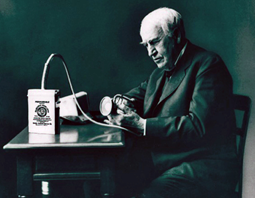 We are hearing more and more about batteries these days for everything from phones and power tools, to cars and computers. All these things can be powered by rechargeable batteries. Just a few decades ago, none of them could be operated that way. But other than the trusty flashlight, we do not think about batteries for architectural lighting, except for limited emergency or egress use. There are a few good reasons: Historically, lighting used a lot of power and the batteries were impractical for all but the most specialized applications. There is a calculation that needs to be done when it comes to battery lighting and it is: time vs. intensity. A little bit of light for a long time, or a lot of light for a short time. Today’s modern LED lights use just a fraction of the power that older lights used, and the battery technology has improved markedly. (Higher power density, rechargeable, smaller, lower cost). Those changes allow more light for a longer time, and so, the equation starts to look more promising.
We are hearing more and more about batteries these days for everything from phones and power tools, to cars and computers. All these things can be powered by rechargeable batteries. Just a few decades ago, none of them could be operated that way. But other than the trusty flashlight, we do not think about batteries for architectural lighting, except for limited emergency or egress use. There are a few good reasons: Historically, lighting used a lot of power and the batteries were impractical for all but the most specialized applications. There is a calculation that needs to be done when it comes to battery lighting and it is: time vs. intensity. A little bit of light for a long time, or a lot of light for a short time. Today’s modern LED lights use just a fraction of the power that older lights used, and the battery technology has improved markedly. (Higher power density, rechargeable, smaller, lower cost). Those changes allow more light for a longer time, and so, the equation starts to look more promising.
If we add to this equation of intensity and time, the use of automatic controls, we can use the light only when it is needed and reduce the intensity when no-one is present. This really stretches out the time variable which also allows the intensity to be increased if desired.
Combining better lights, better batteries, and automatic controls with a solar panel, gets a system that is very close to being autonomous. The system could be just one light that has all these components for an off-grid bus shelter or an outbuilding. Or it could be a more complex structure like a community center with remote solar panels feeding a centralized battery that then powers multiple lights that are arranged in numerous control zones. This could allow it to become an emergency center in the event of a regional grid failure. The key difference is the use of controls to automatically limit the time.

Why do we care? One of the big advantages of batteries is the portability. We can move around with a phone or a power tool and are not tethered by an electrical cord. But buildings do not move around, so what would be the advantage? There is the obvious advantage of having light, and perhaps other small appliances, during a power grid failure. Related to this, but perhaps more compelling is that when we have a solar power system, the time when it is most plentiful, is the time when we need it the least (particularly for lighting). So, if we store the power, then it is available when we need it the most. Whether it is for a single remote parking lot fixture, a microgrid for a whole community, or just one building, this combination of technologies, can be a powerful tool toward building a more robust and resilient lighting system.
Again, a decade ago, it would not have been practical to think about architectural lighting to be battery powered, and it might not be fully cost effective today, but as utilities and our communities begin to examine rebuilding our aging electrical grid infrastructure, it could be timely to think outside the box and see what is possible to minimize our reliance on the traditional grid model.
(photo credit T&D World)
